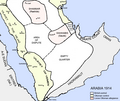Portal:Saudi Arabia
The Saudi Arabia Portal – بوابة المملكة العربية السعودية
Saudi Arabia, officially the Kingdom of Saudi Arabia (KSA), is a country in West Asia and the Middle East. It covers the bulk of the Arabian Peninsula and has a land area of about 2150000 km2 (830000 sq mi), making it the fifth-largest country in Asia and the largest in the Middle East. It is bordered by the Red Sea to the west; Jordan, Iraq, and Kuwait to the north; the Persian Gulf, Bahrain, Qatar and the United Arab Emirates to the east; Oman to the southeast; and Yemen to the south. The Gulf of Aqaba in the northwest separates Saudi Arabia from Egypt and Israel. Saudi Arabia is the only country with a coastline along both the Red Sea and the Persian Gulf, and most of its terrain consists of arid desert, lowland, steppe, and mountains. The capital and largest city is Riyadh; other major cities include Jeddah and the two holiest cities in Islam, Mecca and Medina. With a population of 32.2 million, Saudi Arabia is the fourth most populous country in the Arab world. (Full article...) Selected article -The House of Al Saud (Arabic: آل سُعُود, romanized: ʾĀl Suʿūd IPA: [ʔaːl sʊʕuːd]) is the ruling royal family of Saudi Arabia. It is composed of the descendants of Muhammad bin Saud, founder of the Emirate of Diriyah, known as the First Saudi State (1727–1818), and his brothers, though the ruling faction of the family is primarily led by the descendants of Abdulaziz bin Abdul Rahman, the modern founder of Saudi Arabia. It forms a subtribe of the larger prominent ancient Banu Hanifa tribe of Arabia, from which well known 7th century Arabian theologist Maslama ibn Ḥabīb originates. The most influential position of the royal family is the King of Saudi Arabia, an absolute monarch. The family in total is estimated to comprise 15,000 members; however, the majority of power, influence and wealth is possessed by a group of about 2,000 of them. Some estimates of the royal family's wealth measure their net worth at $1.4 trillion.This figure includes the market capitalization of Saudi Aramco, the state oil and gas company, and its vast assets in fossil fuel reserves, making them the wealthiest family in the world and the wealthiest in recorded history. The House of Saud has had four phases: the Sheikhdom of Diriyah (1446–1744); the Emirate of Diriyah (1727–1818), marked by the expansion of Salafism; the Emirate of Nejd (1824–1891), marked with continuous infighting; and the current state (1902–present), which evolved into the Kingdom of Saudi Arabia in 1932 and now wields considerable influence in the Middle East. The family has had conflicts with the Ottoman Empire, the Sharif of Mecca, the Al Rashid family of Ha'il and their vassal houses in Najd along with numerous Islamist groups both inside and outside Saudi Arabia and Shia minority in Saudi Arabia. (Full article...)Did you know (auto-generated)
News
Related portalsReligions in Saudi Arabia Arab states Other countries WikiProjectsThings you can do
This is a Good article, an article that meets a core set of high editorial standards.
The siege of Mecca in September–November 683 was one of the early battles of the Second Fitna. The city of Mecca was a sanctuary for Abd Allah ibn al-Zubayr, who was among the most prominent challengers to the dynastic succession to the Caliphate by the Umayyad Yazid I. After nearby Medina, the other holy city of Islam, also rebelled against Yazid, the Umayyad ruler sent an army to subdue Arabia. The Umayyad army defeated the Medinans and took the city, but Mecca held out in a month-long siege, during which the Kaaba was damaged by fire. The siege ended when news came of Yazid's sudden death. The Umayyad commander, Husayn ibn Numayr al-Sakuni, after vainly trying to induce Ibn al-Zubayr to return with him to Syria and be recognized as Caliph, departed with his forces. Ibn al-Zubayr remained in Mecca throughout the civil war, but he was nevertheless soon acknowledged as Caliph across most of the Muslim world. It was not until 692, that the Umayyads were able to send another army which again besieged and captured Mecca, ending the civil war. (Full article...) Selected pictureMore did you know
General imagesThe following are images from various Saudi Arabia-related articles on Wikipedia.
Featured contentFeatured articlesGood articles
Associated WikimediaThe following Wikimedia Foundation sister projects provide more on this subject:
Sources
Discover Wikipedia using portals | ||||







![Image 1A view of Jabal Sawda, a peak located in Saudi Arabia, with an elevation of around 3,000 metres (9,843 ft).[1]](http://upload.wikimedia.org/wikipedia/commons/thumb/5/59/Al_Sawda_peak.jpg/120px-Al_Sawda_peak.jpg)






















































